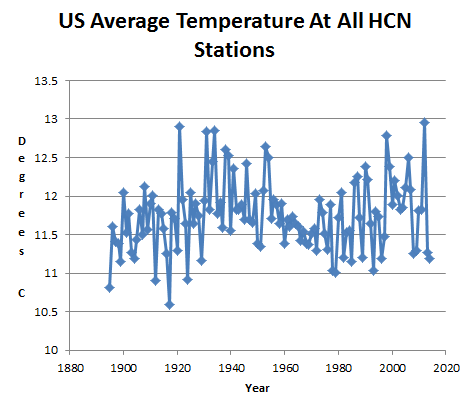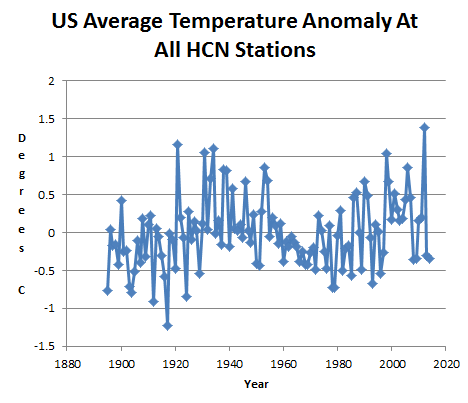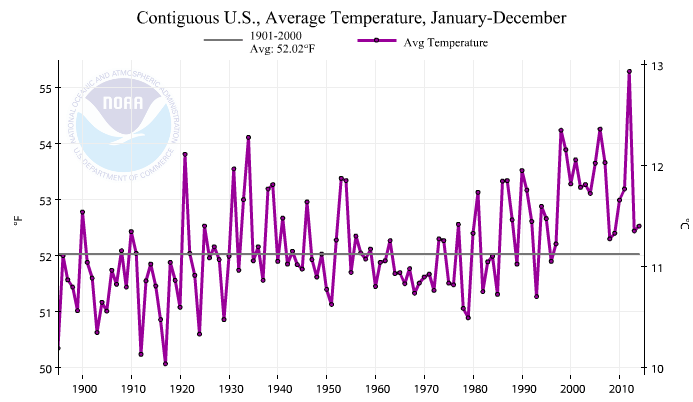Zeke Hausfather claimed that US temperatures had to be measured as anomalies, rather than absolute temperatures – because of “changing station composition.” Several skeptics took the bait.
This is nonsense. The absolute temperature and anomaly graphs are nearly identical. This is because the US has a large number of widely distributed stations, and random station changes tend to null each other out over the entire group.
NCDC reports US temperatures as absolute temperatures, because they know it doesn’t make much difference.
People should do some research before weighing in on topics they don’t understand. The important topic is the huge amount of data tampering, not the minute and nearly irrelevant details alarmists use to distract.






Why do they tinker with land station records when it is clear oceans are making temperature changes?
https://rclutz.wordpress.com/2015/05/10/empirical-evidence-oceans-make-climate/
Because they need the propaganda? They MUST make the over all temperatures appear to be rising globally. It isn’t about science, it’s about an agenda.
I agree. Climate alarmists are pure propagandists. The science doesn’t matter to them.
1. One “important topic is the huge amount of data tampering, not the minute and nearly irrelevant details alarmists use to distract.”
2. Another is psychological deceit, using anomalies (that might change by 100%) rather than absolute values (that might change by 1%) for the same measurements.
3. A third and more sophisticated form of psychological deceit involves calculating and reporting anomaly values that differ from a variable standard, e.g., the values of Dr. Carl von Weizsacker’s average nuclear binding energy are
_ a.) Systematically high for neutron-rich nuclei, and
_ b.) Systematically low for proton-rich nuclei
Weizsacker exaggerated the effect of Coulomb repulsion between protons and obscured the effect of non-Coulomb repulsion between neutrons.
OT Steve but your up on Michel Malkins’ Twitchy. http://twitchy.com/2015/05/09/mainstream-media-forecasts-of-the-end-of-snow-somewhat-premature-photos/
Thanks for that link. Steven is a one-man Army!
your should have been you’re.
You can chuse an alternative spelling, rah. Our Founding Fathers did:
http://www.usconstitution.net/constmiss.html
In Colorado, including the Denver area, this will be the second snowy Mother’s Day weekend in a row. A storm spanning May 11-12, 2014, brought several inches of snow to the Denver area with 10-30 inches in parts of the foothills and mountains.
The storm this weekend is likely to be the biggest of the snow season in Rapid City and push the city well above average. Prior to this storm, about 36 inches of snow has fallen on Rapid City. Typical seasonal snowfall is about 40 inches.
I believe I’ve seen somewhere evidence that more temperature data adjustment (upwards, of course) happens in the NH cold months of December through March than any other time of the year. Could you check that out? Or have you already?
“….Temperature rises faltered, so the data was altered,
The pseudo-scientists must protect their illusion,
Their political masters demand warming disasters,
Misinformation abounds in profusion…..”
Read more: http://wp.me/p3KQlH-FY
The big difference, of course, is that anomalies are measured against a “baseline period” that can be manipulated at whim without any regard for scientific of statistical justifications.
Absolute temperatures are what they are, but a “baseline” temperature range can be “conveniently” selected to paint the picture that current temperatures exhibit a large deviation from a perceived “normal.” Also, the baseline period can be adjusted to counteract pesky absolute temperature data that doesn’t corroborate the prevailing hypothesis. The shapes of the curves are the similar, but there is no deviation against a baseline in absolute temperature data since a baseline makes no sense in that context.